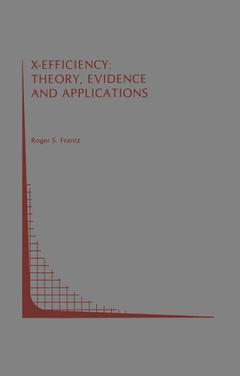1. Introduction.- 1.1. Introduction.- 1.2. X- and allocative efficiency, and the welfare losses from monopoly power.- 1.3. X-efficiency, and the neoclassical production and cost functions.- 1.4. The development of XE theory.- 1.5. XE theory and generalized neoclassical theory..- 1.6. XE theory as a research design.- 1.7. Empirical research on XE theory.- 1.8. Critics of XE theory.- 2. Production, cost, and welfare: A review.- 2.1. Introduction.- 2.2. The firm in the short run.- 2.3. The firm in the long run.- 2.4. Firms, markets, and efficiency.- 2.5. Implications.- Appendix: Regulation theory and X-efficiency.- 3. X-efficiency: The intellectual setting and an introduction to the theory.- 3.1. Introduction.- 3.2. Complex objective functions.- 3.3. XE theory: An introduction.- 3.4. Conclusions.- 4. X-efficiency theory: 1.- 4.1. Introduction.- 4.2. The individual in XE theory.- 4.3. Individual effort and the inert area.- 4.4. Conclusions.- 5. X-efficiency theory: 2.- 5.1. Introduction.- 5.2. Intrafirm determinants of individual and group effort.- 5.3. Productivity, effort conventions, and the prisoner’s dilemma.- 5.4. Market structure, pressure, and effort.- 5.5. A synthesis and an illustration.- 5.6. Implications and conclusions.- Appendix: Regulation and X-efficiency.- 6. Empirical evidence: Regulated industries.- 6.1. Introduction.- 6.2. Electric Utilities.- 6.3. Local government services.- 6.4. Symphony orchestras.- 6.5. Airlines.- 6.6. Conclusions.- 7. Empirical evidence: Ownership form.- 7.1. Introduction.- 7.2. Owner- versus manager-controlled firms.- 7.3. Public versus private ownership.- 7.4. Conclusions.- 8. Empirical evidence: Market structure.- 8.1. Introduction.- 8.2. Output and input ratios.- 8.3. Profits and X-efficiency.- 8.4. Price-fixing behavior.-8.5. Conclusions.- 9. X-efficiency, its critics, and a reply.- 9.1. Introduction.- 9.2. Rent-seeking.- 9.3. Leisure as output.- 9.4. Management utility under competition.- 9.5. Property rights.- 9.6. Some general comments.- 10. Implications and conclusions.- 10.1. X- and Allocative Efficiency.- 10.2. X-efficiency theory as a research design.- 10.3. X-efficiency and its critics.- 10.4. X-efficiency theory and neoclassical theory: Some final thoughts.- References.



